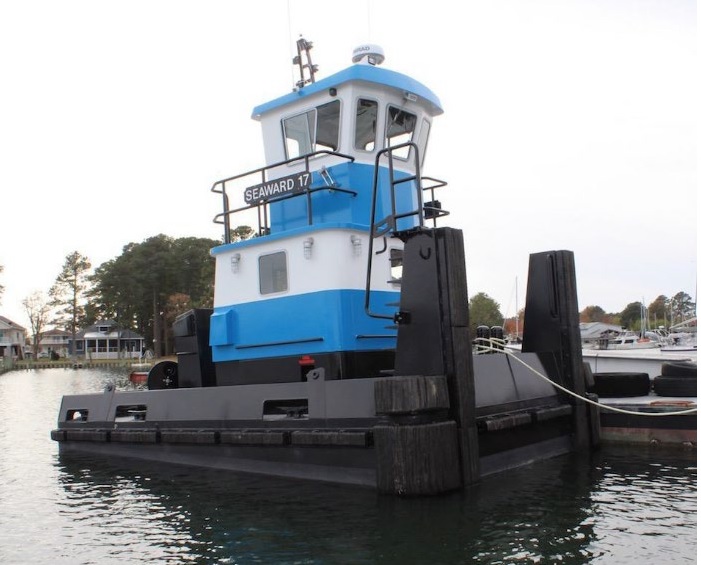Elliott Bay Design Group (EBDG) and Miller Marine announced in November that the two companies would design and build a fully electric truckable push tug.
The 26' tug is purposefully designed as a multifunctional utility boat servicing marine construction sites, tending dredges, tending buoys, short range ferry operations and other near shore operations such as crew transportation or line handling, EBDG said. The tug will be a test case to understand the market demand for an all-electric vessel.
Miller Marine, a boat building and steel fabrication company based in Deltaville, Va., builds assorted workboats and passenger vessels. Seattle-based EBDG is a naval architecture company that has been in business for 36 years. They have designed vessels ranging from 20' to 700'.
A request for designing an electric truckable tug
Last year, Miller Marine reached out to EBDG to discuss partnering on development of a battery-electric option for Miller's popular truckable tug design.
Knowing that EBDG had experience with designing hybrid-electric ferries, Miller Marine saw a market opportunity for an electric version of a truckable tug design they had been building for several years — a result of new EPA regulations and government grants for zero and low emission vessel construction. Also, other states are starting to follow California’s lead in giving credit to low-emission or zero-emission operations, making the use of electric tugs more desirable.
An industry-first electric tugboat
For EBDG, the new electric tug is another significant step in its goal to become market leaders of green and alternate fuel technologies, as well as an industry-first and test case to understand the market demand for an all-electric option that operates differently than a diesel tug. The electric tug will be built in an inland style with a lot of room in the hull for batteries. EBDG will incorporate an electrical propulsion system into Miller Marine's truckable tug design. Once the design phase is complete, Miller Marine will build the vessel at its 15,000-sq.-ft. production facility.
Designing electric or hybrid vessels is a bigger and more complex design challenge, said Mike Complita of EBDG. “Although the hull itself is easily adapted to an all-electric option, the biggest challenge is to work with multiple smaller component providers who don’t offer a complete integrated solution, which means picking each component individually and ensuring everything communicates together properly and effectively,” he said.
One example is proprietary shore power plugs, which are being developed by several companies and must be treated differently than land-based applications.
Design phase and production roadmap
EBDG’s primary 3D design tool is Rhino, which integrates with AutoCAD. Other software tools used by EBDG are Navisworks and ShipConstructor for reviewing and performing structural analysis.
The tug is made up of two pieces — a shoe box-looking hull and a customizable superstructure with an enclosed steering station. Both pieces can be loaded separately on a single flatbed trailer and towed anywhere in the U.S. without the need for any special permitting or road closures. EBDG is currently working with vendors to select the tug's components and equipment. Construction is scheduled to begin in the summer with the first tug completed and put in operation by the first quarter of 2024.
Size and configuration details
The 26' vessel will be powered by two permanent magnet motors with a total power of over 300 kW (400 hp). The new tug will not only be truckable, but 26' is also the cutoff for Subchapter M oversight by the Coast Guard.
Shore power will be used to recharge the vessel's battery banks overnight, taking about eight hours. On a full charge, the vessel will operate with contingency for 12-plus hours. A closed-loop fluid cooling system will provide temperature control of the batteries, motors and electronics, maximizing their lifetime. This configuration is ideally suited for shallow and silty water operations, EBDG said.
The future for electric tugboats is looking bright
The electric tug is designed to support public agency and private enterprise marine construction operations and short-range logistics, with dredging being a key market. Dredging that requires truckable tugs is typical in a port or near-shore body of water. Thus, the customer doesn’t have to go far out to do dredging work so they can come back and charge at night. An in-port application would provide access to electrical recharging power at the shore. “This tug also offers customers the option to truck it into landlocked sites instead of building it on site and having it stuck there,” said Complita.
In the next two years, a similar type of electric boat designed for fleeting operations will hit the water. This fleeting boat scales the current design up about three to four times to create a giant raft of barges that are pushed down a river by a larger tug with long-range capability. The new fleeting boat design will provide a zero emission option to manage individual barges.





